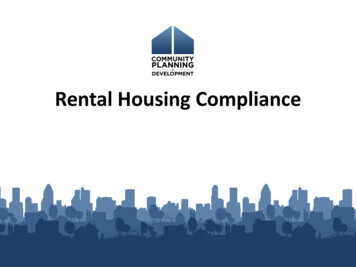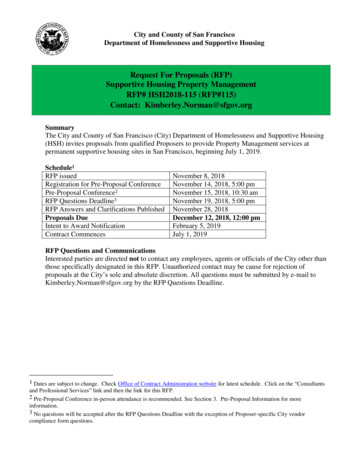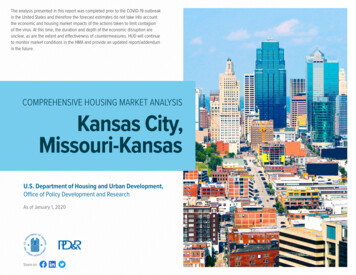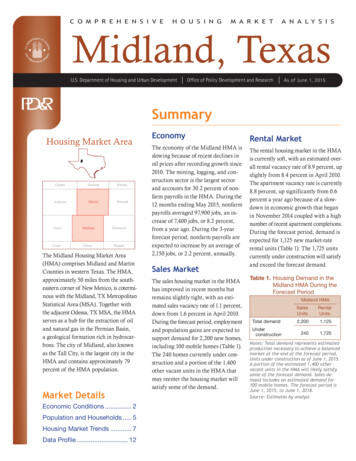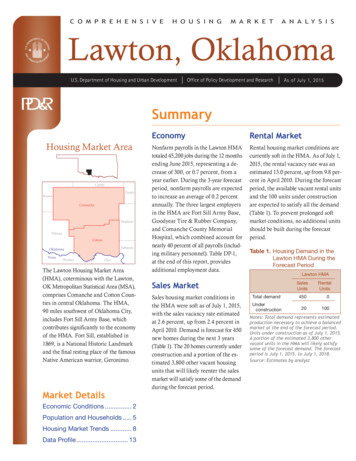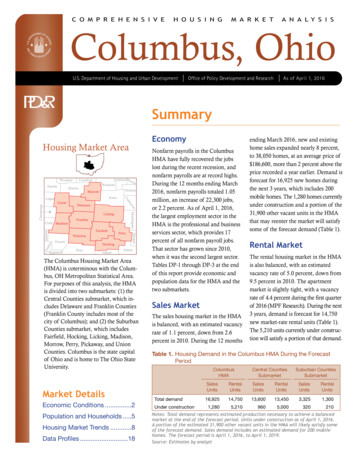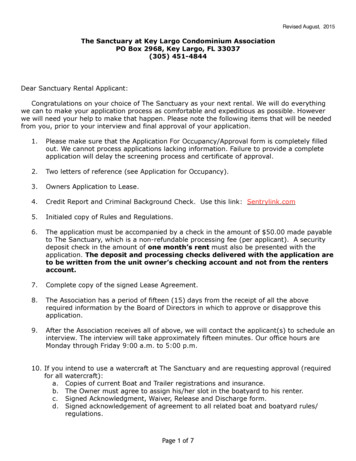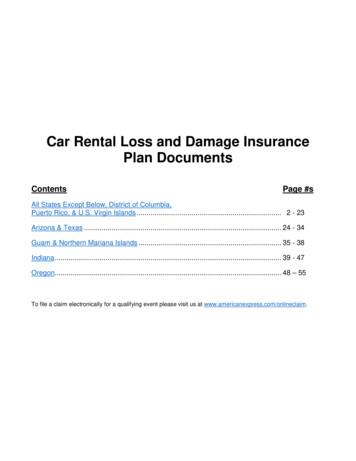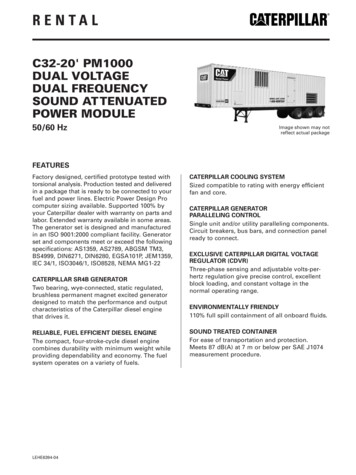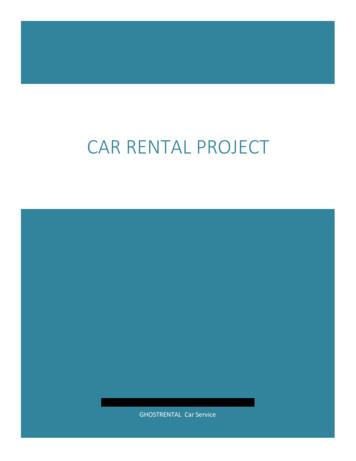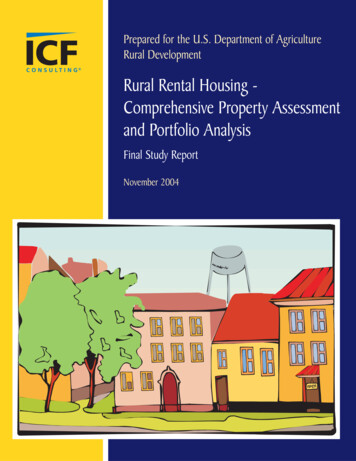
Transcription
Prepared for the U.S. Department of AgricultureRural DevelopmentRural Rental Housing Comprehensive Property Assessmentand Portfolio AnalysisFinal Study ReportNovember 2004
AcknowledgementsThis report was prepared by the ICF Consulting Team under contract to the U.S.Department of Agriculture (USDA) Rural Development. The Rural Housing Service isan agency of USDA Rural Development.The ICF Team included Shekar Narasimhan and Tom White of Beekman Advisors; RickSamson of AEW Capital Management, L.P.; Charlie Wilkins of The Compass Group,LLC; Ned Daly and David Whiston of On-Sight Insight; Patrick Carter of Carter &Associates; and Eric Oetjen and Kevin Blake of ICF Consulting.The Team expresses its appreciation to the USDA staff for their diligent work andsupport of our analysis. The USDA’s State and Field Offices should also becommended for their support, especially during the physical needs assessments whenthey helped ensure our access to property managers and owners. Last, the Teamthanks the Multi-family Advisory Board for providing invaluable insight into theprogram’s history and how it could evolve to address its current challenges.Questions or comments on this report should be directed to:Eric OetjenVice PresidentICF Consulting9300 Lee HighwayFairfax, VA en@icfconsulting.com
MemorandumDate: November 17, 2004To:Russell DavisJack GleasonThomas DorrCC:Stephanie WhiteFrom: ICF Consulting TeamSubject: Comprehensive Property Assessment Study - Final Study ReportThis document and the accompanying briefing slides (see attachment) summarizing therecommended Multi-family Housing Revitalization Strategy constitute the Project Team’s Final StudyReport for the Rural Rental Housing – Comprehensive Property Assessment Study. Further detailand information can be found in the Market Assessment Report that was prepared as part of thestudy. This report is included as an Appendix.Origins of the Multifamily housing program: The Housing Act of 1949; Title V of P.L. 81-171(October 25, 1949) authorized the USDA to make loans to farmers to construct, improve, repair, orreplace dwellings and other farm buildings to provide decent, safe, and sanitary living conditions forthemselves, their tenants, lessees, sharecroppers, and laborers. Over time, the Act has beenamended to authorize housing loans and grants to rural residents in general. The USDA’s RuralDevelopment (RD) mission area administers these programs. The housing loan and grant programsincluded single and multi-family housing programs. This proposal deals specifically with the multifamily program covered under Section 515 of the Act whereby loans are made at a 1% rate for thedevelopment of rural rental housing.Background to Comprehensive Property Assessment Study (CPA): After the Administrationtook office, the Department determined that the portfolio of Section 515 properties was in suchcondition and of such concern that an assessment of the situation was imperative. The studyportfolio on November 1, 2003 encompassed 15,899 properties with a total of 434,296 units andexcluded farm labor housing. These properties are located across the country in areas defined rural.The CPA was initiated in September 2003 using outside consultants to do the following:1. Review issues and develop solutions directly pertaining to the market demand for suchhousing.2. Review and define potential approaches to address the increasing propensity for owners toprepay RD subsidized loans and thereby displace needy tenants.3. Analyze and develop solutions for the increasing rehabilitation and recapitalizationrequirements of the aging existing properties.CPA – Final Study Report1
11/17/2004Comprehensive Property Assessment Study - Final Study ReportThis assessment, including 333 detailed field inspections and 32 market studies, has beencompleted and a revitalization proposal has been developed which has the support of RuralDevelopment and has been reviewed by Office of General Counsel (OGC) and Office of Budget andProgram Analysis (OBPA). This memorandum summarizes the findings and the potentialimplications of the proposal.Study Results and Implications: The following is a summary of some of the facts gleaned from thestudy: 40% of the loans have been made on age-restricted properties; overall the existing tenantbase is 58% elderly, handicapped and disabled, or both; the average property age is 23years; the average annual adjusted household income is 9,075.Based on a sample of properties, which the Department selected in order to be statisticallyvalid, the following was determined.o While there are few immediate life & safety issues, no property has adequatereserves or sufficient cash flow to do needed repairs and for adequate maintenanceover time.o Doing nothing is not an option unless the roofs never leak, the paint job lastsforever, no furnaces or air-conditioners ever need replacement, etc.Several factors may contribute to owners lacking motivation to maintain, upgrade, or transfertheir properties, including tax consequences, lack of equity in the property, and the inability toreceive a return on investment.The location, physical condition and tenant profile of the properties suggest that the publicinterest is best-served by revitalizing most of this housing as affordable housing for the longterm.Based on the data we reviewed and reasonable economic assumptions, a large majority ofthe owners do not have an economically attractive alternative to continuing in the program,and therefore we think prepayment is unlikely to occur at the rates previously assumed.Using a combination of approaches and adopting market-based solutions with private sectorresources, we believe, over time, that Rural Development can address the financial and physicaldeterioration issues. Under our suggested approach, costs to the Government will be significantlyless than if these same issues are addressed using traditional approaches. However, it is clear thataddressing these issues will cost more than the current budget “baseline” can support. In any event,continuing the status quo is an unattractive alternative; continued pressure on the Rental Assistancebudget as costs go up and tenant incomes remain low; deterioration of the properties causingforeclosures and tense, unproductive relationships with private owners distracting attention from thefuture of the rural communities being served.The Multifamily Revitalization Proposal: This proposal has three main components and must beviewed as a package – partial implementation, in our view, will only cause confusion and increasecosts substantially: Additional capital and a new bargain with the owners and tenants: the capital would comeprimary from debt relief on the current RD loans with built-in recapture provisions and newprivate capital- including potential co-investment by the owners. The new bargain would bethat owners must accept a regulatory and enforcement regime that would ensure affordabilityand accountability for performance, but also offer incentives for good ownership and goodmanagement. A minimum contribution for shelter would be expected from all tenants.CPA – Final Study Report2
11/17/2004Comprehensive Property Assessment Study - Final Study Report Market determines prepayment: RD would protect current tenants for a finite period (asdetermined by Congress and the Administration) from the rent burden that would result fromprepayment. For purposes of modeling the level of resources needed, we used a five-yearperiod of protection for currently assisted tenants to be consistent with pre-2004 RentalAssistance Contract renewals (a 30-month protection period was used for non-assistedtenants). Allowing the market to determine prepayment avoids potential windfalls to owners,and goes beyond the current focus of preventing prepayment with limited resources. Reorganize the multifamily program: To meet the challenges of implementing the newfunctions under the Revitalization Initiative, we recommend expanding the Agency’s technicalexpertise, and making organizational changes that provide the Agency the authority,flexibility, and accountability to succeed. We are proposing the establishment of anempowered Office of Portfolio Revitalization (OPR), which would be exclusively focused onthe existing portfolio. We have broken the entire portfolio into five (5) transaction types andanalyzed the resources necessary to address the long-term recapitalization needs. Thisprogram envisages a significant role for the State RD offices as well as outside experts.Anticipated Budget Impact: After OBPA reviewed detailed assumptions provided by theconsultants, the initial determination was that the budget impact of debt relief, tenant protection,capital advances and administrative costs over the seven years would be approximately 1.0 billionabove the baseline. However, to accomplish the same result of preserving affordable housing for 20years using Rental Assistance (currently the only real tool available) we estimate the cost to be ashigh as 2.9 billion above current funding levels. We propose a staged approach with periodiccheck-points and accountability for the Multifamily Revitalization Strategy.Conclusion: The Multi-Family Section 515 portfolio at USDA, representing a federal investment ofnearly 12 billion, was created over 30 years and serves some of the poorest and most underservedin rural communities. The essence of the Multifamily Revitalization Proposal is to comprehensivelyaddress all the issues facing the program and to provide all stakeholders with an equitable deal: Owners get a reasonable return for providing capital and good management Congress and the Administration know they are getting results for the dollars spent RD is perceived as providing leadership and focused management Local communities have an affordable housing asset in which they have pride and Above all, tenants are protected while Department’s portfolio is revitalizedThank you.CPA – Final Study Report3
ATTACHMENT:EXECUTIVE BRIEFING
USDA – RD MultifamilyRevitalization StrategyThe Comprehensive PropertyAssessment Report:Executive BriefingICF Consulting TeamNovember 17, 2004
Overview Current SituationThe Opportunity – Revitalization InitiativePrecursors to ExecutionHighlights of Revitalization InitiativeNext StepsICF Consulting Team2November 17, 2004
Current USDASection 515 PortfolioThe portfolio encompassed 15,899 propertieswith 434,296 units as of November 1, 2003– Significant segment of existing tenants are elderly,disabled or handicapped, or both (58%)– Average property age is 23 years– Average annual tenant income is 9,075As of August 31, 2004, the average outstandingloan balance was 25,722/unitICF Consulting Team3November 17, 2004
Physical Needs Study FindingsRandom sample of 333 properties received on-siteassessments– Sample of properties selected by USDA economists– Drawn to be representative of portfolioDuring physical needs inspections, we learned that:– No serious immediate health & safety problems were discovered– Many properties face significant physical needs in the immediatefuture– No property has sufficient current reserves, or provision for futurereserves, to address physical needs over timeICF Consulting Team4November 17, 2004
Current SituationIs Not SustainableIf new funds are not invested in these properties, 2/3rdsof the portfolio will only be able to maintain itscurrent status if:–––––––The roofs never leakThe paint job lasts foreverThe building siding is everlastingNo potholes ever develop in the parking lotNo one will ever need to replace a furnace or air conditionerNo doors will ever rust or rotAll windows will work foreverICF Consulting Team5November 17, 2004
Current SituationIs Not Sustainable (Cont.) If rent increases match inflation:– Properties will not be able to meet their major repair andreplacement needs– Most 515 loans will go into default– And if rent increases are below inflation, problems escalategeometrically! Problem cannot be solved by rent increasesbecause:– Vacancy rates will increase– Unassisted tenants will suffer– RA costs will be unacceptably highICF Consulting Team6November 17, 2004
Doing Nothing IsNot a Viable OptionDoing nothing is not a viable option because:– Aging, obsolescent properties will only get more so– The gap between current and needed funding for capital reserveswill only grow larger (harder to catch up)– Delaying action to address physical needs results in greater costas building systems and components fail causing further physicaldeterioration.– Property deterioration will occur risking the health, safety, andultimately the availability of housing for those most in need –low-income families, and elderly or disabled households– Several factors may contribute to owners lacking motivation tomaintain, upgrade, or transfer their properties, including taxconsequences, lack of equity in the property, and the inability toreceive a return on investmentICF Consulting Team7November 17, 2004
Current Situation:Prepayment Prepayment is a contract right for all pre-1989 loans:– Available to estimated 61% of properties (62% of units)– Nearly half of these properties could prepay now & the restonce their 20-year restrictions expire (all by 2009)– Legislation conditioning prepayment was enacted in 1987, andthese conditions have been the subject of recent court rulings.(Note: The Consulting Team did not evaluate the impact of thecourt decisions because judicial actions affecting the portfoliowere outside the scope of the study.)ICF Consulting Team8November 17, 2004
Current Situation:Prepayment Of 9,698 properties with the potential toprepay:– An estimated 1,648 properties would beeconomically viable to prepay. This is 10.4% of allproperties.– This estimate represents 10.6% of total units inthe programICF Consulting Team9November 17, 2004
The Opportunity RD can resolve these portfolio issues And should begin immediately! Market analysis results show that the portfoliocontinues to serve a needed purpose & is worthy ofrevitalization RD can address both prepayment & physicaldeterioration in the portfolio using a combination ofapproaches over time Done comprehensively, this can be a win-win for thegovernment, owners, tenants and local communitiesICF Consulting Team10November 17, 2004
The Opportunity (Cont.) Revitalization will cost budget dollars but a lot less andmore viable than doing nothing or continuing with thecurrent program and tools:– Estimate that our own recommended approach costs less thanhalf what it would cost to stabilize the portfolio with rentincreases and RA and new 515 funds– Achieved primarily through reducing required payments onexisting 515 loans with some additional capital tools & creationof a specialized team Resources can & should be leveraged from otherhousing programs (e.g., LIHTC, HOME funds)– RD is creating new partnerships with GSE’s & State housingagenciesICF Consulting Team11November 17, 2004
The Opportunity (Cont.) Policy Focus: Allow prepayment & protect thetenants. Protections could take any or all ofthe following forms:– Vouchers which might include rent and/or time limits– Homeownership assistance– One-time cash award In prepayment cases, we are proposing toextend rent increase protection to current RAand eligible non-RA tenants (as Congressmandated for HUD)ICF Consulting Team12November 17, 2004
The Opportunity:Policy Decision #1 Focus on protecting the tenants, not allproperties Allow prepayment in pre-1989 properties– Pre-1979 properties - no restriction– 1979 to 1989 properties - upon expiration ofestablished 20-year use restriction– Existing tenants protectedICF Consulting Team13November 17, 2004
The Opportunity:Policy Decision #2 Proactively get ahead of physicaldeterioration– In the entire portfolio– Focus for the next few years on recapitalization ofexisting properties– Allocate the significant resources necessary toachieve thisICF Consulting Team14November 17, 2004
The Opportunity:Policy Decision #3 Revitalize the program in a comprehensiveway:– deregulate certain aspects– increase utilization of private sector participants– test new ideas to bring capital to rural rentalhousing– demonstrate viability of program particularly forelderly properties to stay in the program This requires new tools and organizationalchangesICF Consulting Team15November 17, 2004
Precursors toExecutionKey FeFedederarall ActionsStep 1. RD resolves policy issues outlinedoutlinedin MaMarket AnalysisStep 2. RDHSpresentspresentsReviRevitalizatitalizationon ProgramProgramrecommendations to CongressStep 3. Congressional action to authorizeRevitalization Program & appropriate initial fundingStep 4. ionProgram with Admin Notices and regulationsStep 5. Congress appropriatesappropriates ongoingfunding for Revitalization ProgramICF Consulting Team16November 17, 2004
Precursors toExecution (Cont.) RD is taking the first steps by:– Developing a statement of needed authorizinglegislation & funding needs– Describing RD decisions on major policy issues– Defining the key elements of the revitalizationprogram, including organizational structure Congress can then discuss and debate theissues, authorize & appropriate initial programfunding (See Figure 1)ICF Consulting Team17November 17, 2004
Precursors toExecution (Cont.) After Congressional authorization, but prior todepartmental implementation:– RD will need to act on several key tasks(as Figure 2 illustrates)– Illustrates the types of tasks necessary, butis not intended to be all-inclusiveICF Consulting Team18November 17, 2004
Revitalization Initiative RD needs to adopt an effective, workablerevitalization program methodology– We are proposing that the portfolio beorganized into five (5) major transaction types– Use efficient tools appropriate to scale & risk– Comprehensive, multi-faceted approach isneeded– Figure 3 describes the tools needed andestimated total implementation costsICF Consulting Team19November 17, 2004
Program Design forExecution of Transactions Developed by new Office of PortfolioRevitalization, in consultation with existingRD staff, OGC, OBPA––––––New regulatory structureStreamlined prepaymentDebt restructure approachStandard legal documentsRegulationsGuidance, training, & technical assistanceICF Consulting Team20November 17, 2004
Transaction Type 1:Prepayment Tenants protected adequately– RD & Congress determine form(s) of protection Owners may prepay once RD determines thatthe project is eligible and that tenants areprotected We estimate likely prepayment of almost 1,600properties involving almost 46,000 units OPR creates & oversees; administered by StatesICF Consulting Team21November 17, 2004
Transaction Type 2:No Restructure For properties that can cover their operatingand capital replacement needs at currentrents– Or with rents up to (say) 10% higher Future rent increases will match inflation Existing regulatory structure continues Transaction Type 2 we estimate includesalmost 1,500 properties ( 49,000 units) OPR creates; administered by StatesICF Consulting Team22November 17, 2004
Transaction Type 3:Simple Restructure Owner is in “good standing”2-24 unit propertiesDebt relief by itself is sufficientExisting 515 loan restructured––––No required monthly paymentNew payment is x% of excess cash at year endStandard legal documents, no variationNew regulatory structure Transaction Type 3 we estimate includes almost3,800 properties ( 63,000 units) OPR creates; administered by StatesICF Consulting Team23November 17, 2004
Transaction Type 4:Moderate Restructure Owner is in “good standing”25-50 unit propertiesDebt relief by itself is sufficientExisting 515 loan restructured––––New, lower required monthly paymentAdditiona
11/17/2004 Comprehensive Property Assessment Study - Final Study Report This assessment, including 333 detailed field inspections and 32 market studies, has been completed and a revitalization p
